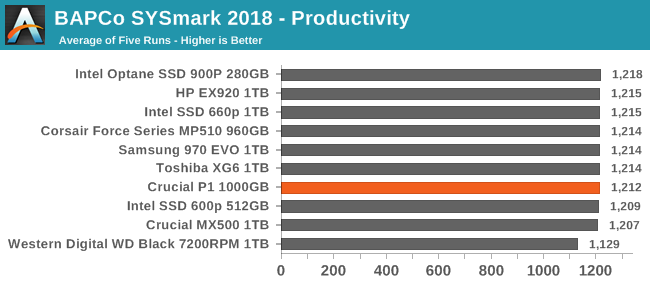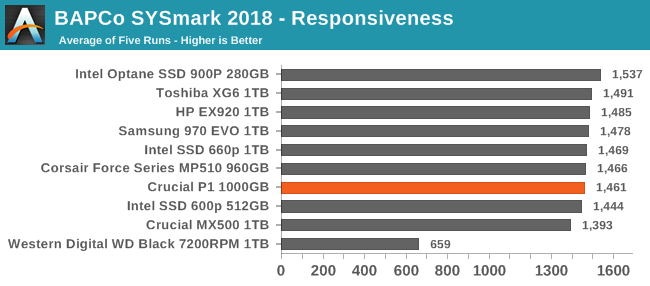The Crucial P1 1TB SSD Review: The Other Consumer QLC SSD
by Billy Tallis on November 8, 2018 9:00 AM ESTBAPCo SYSmark 2018
BAPCo's SYSmark 2018 is an application-based benchmark that uses real-world applications to replay usage patterns of business users, with subscores for productivity, creativity and responsiveness. Scores represnt overall system performance and are calibrated against a reference system that is defined to score 1000 in each of the scenarios. A score of, say, 2000, would imply that the system under test is twice as fast as the reference system.
SYSmark scores are based on total application response time as seen by the user, including not only storage latency but time spent by the processor. This means there's a limit to how much a storage improvement could possibly increase scores, because the SSD is only in use for a small fraction of the total test duration. This is a significant difference from our ATSB tests where only the storage portion of the workload is replicated and disk idle times are cut short to a maximum of 25ms.
| AnandTech SYSmark SSD Testbed | |
| CPU | Intel Core i5-7400 |
| Motherboard | ASUS PRIME Z270-A |
| Chipset | Intel Z270 |
| Memory | 2x 8GB Corsair Vengeance DDR4-2400 CL17 |
| Case | In Win C583 |
| Power Supply | Cooler Master G550M |
| OS | Windows 10 64-bit, version 1803 |
Our SSD testing with SYSmark uses a different test system than the rest of our SSD tests. This machine is set up to measure total system power consumption rather than just the drive's power. The test is run five times in a row on each hardware configuration, and the average scores are reported below.



The creativity and productivity scenarios are relatively unaffected by storage performance, and depend much more on compute power. The responsiveness scores are more dependent on storage performance, but even so the differences between SSDs are fairly small. The Crucial P1 is outperforms the MX500 SATA drive but is a bit slower than the high-end NVMe drives.
Energy Usage
The SYSmark energy usage scores measure total system power consumption, excluding the display. Our SYSmark test system idles at around 26 W and peaks at over 60 W measured at the wall during the benchmark run. SATA SSDs seldom exceed 5 W and idle at a fraction of a watt, and the SSDs spend most of the test idle. This means the energy usage scores will inevitably be very close. A typical notebook system will tend to be better optimized for power efficiency than this desktop system, so the SSD would account for a much larger portion of the total and the score difference between SSDs would be more noticeable.

The energy consumption scores for the SSDs reflect the general trend that higher performance comes with the cost of worse power efficiency. SATA SSDs still lead the rankings for most efficient drive, and the hard drive that's included for comparison purposes required more energy than even the power-hungry Intel Optane SSD 900P.










66 Comments
View All Comments
DanNeely - Thursday, November 8, 2018 - link
When DDR2 went mainstream they stopped making DDR1 dimms. The dimms you could still find for sale a few years later were old ones where you were paying not just the original cost of making them, but the cost of keeping them in a warehouse for several years before you bought them. Individual ram chips continued to be made for a while longer on legacy processes for embedded use but because the same old mature processes were still being used there was no scope for newer tech allowing cost cutting, and lower volumes meant loss of scale savings meaning that the embedded world also had to pay more until they upgraded to new standards.Oxford Guy - Thursday, November 8, 2018 - link
The point was:"QLC may lead to higher TLC prices, if TLC volume goes down and/or gets positioned as a more premium product as manufacturers try to sell us QLC."
Stopping production leads to a volume drop, eh?
romrunning - Thursday, November 8, 2018 - link
"There is a low-end NVMe market segment with numerous options, but they are all struggling under the pressure from more competitively priced high-end NVMe SSDs."I really wish all NVMe drives kept a higher base performance level. QLC should have died on the vine. I get the technical advances, but I prefer tech advances increase performance, not ones that are worse than their predecessor. The price savings, when it's actually there, isn't worth the trade-offs.
Flunk - Thursday, November 8, 2018 - link
In a year or two there are going to be QLC drives faster than today's TLC drives. it just takes time to develop a new technology.Oxford Guy - Thursday, November 8, 2018 - link
Faster to decay, certainly.As I understand it, it's impossible, due to physics, to make QLC faster than TLC, just as it's impossible to make TLC faster than MLC. Just as it's impossible to make MLC faster than SLC.
Workarounds to mask the deficiencies aren't the same thing. The only benefit to going beyond SLC is density, as I understand it.
Billy Tallis - Thursday, November 8, 2018 - link
Other things being equal, MLC is faster than TLC and so on. But NAND flash memory has been evolving in ways other than changing the number of bits stored per cell. Micron's 64L TLC is faster than their 32L MLC, not just denser and cheaper. I don't think their 96L or 128L QLC will end up being faster than 64L TLC, but I do think it will be faster than their 32L or 16nm planar TLC. (There are some ways in which increased layer count can hurt performance, but in general those effects have been offset by other performance increases.)Oxford Guy - Thursday, November 8, 2018 - link
"Other things being equal, MLC is faster than TLC and so on"So, other than density, there is no benefit to going beyond SLC, correct?
Billy Tallis - Thursday, November 8, 2018 - link
Pretty much. If you can afford to pay for SLC and a controller with enough channels and chip enable lines, then you could have a very nice SSD for a very unreasonable price. When you're constrained to a SATA interface there's no reason not to store at least three bits per cell, and even for enterprise NVMe SSDs there are only a few workloads where the higher performance of SLC is cost-effective.Great_Scott - Monday, November 12, 2018 - link
They should drop the SLC emulation and just sell the drive as an SLC drive. Sure, there may be some performance left on the table due to the limits of the NVME interface, but the longevity would be hugely attractive to some users.They'd make more money too, since they could better justify higher costs that way. In fact, with modern Flash they might be able to get much the same benefit from MLC organization and have roughly half the drive space instead of 25%.
Lolimaster - Friday, November 9, 2018 - link
Do not mix better algorithms of the simulated SLC cache and dram with actual "performance", start crushing their simulated cache and the TLC goes to trash.